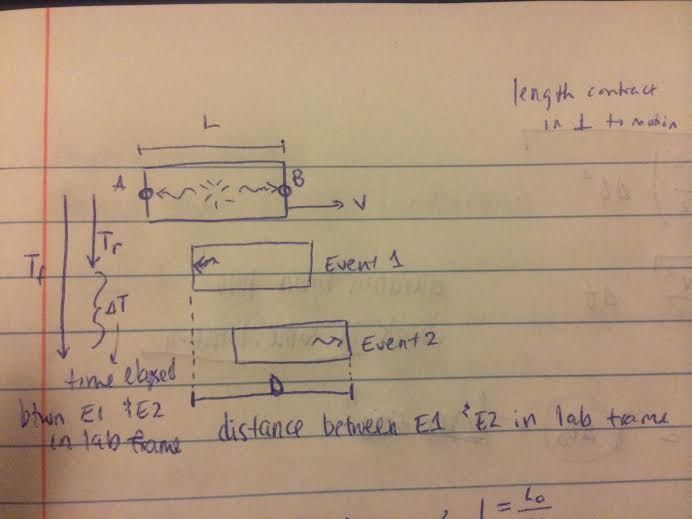1. The problem statement, all variables and given/known data
Derive Phase difference between clocks with distance
2. Relevant equations
I honestly don't understand how this equation ΔT = vD/c2 is derived/figured out.
3. The attempt at a solution
We haven't covered Lorentz Transformations yet so is there a way to explain this to me without using it? I understand the concept of simultaneity, time dilation, and length contraction. This problem deals with the first two. The situation is a rectangular box with two detectors on either end marked with the left as A and the right as B. The box is centered along vertical axis where a flash of light in the center of the box flashes, and the light moves towards left and right towards the detectors. Now the box is moving at a constant velocity to the right.
A picture is attached because it's hard to explain. L is the length of the box, D is the distance between panel 2 and panel 3. Tr is the time it takes for the light to travel to the left detector (Event 1) and Tf is the time it takes for the light to travel to the right detector (Event 2).
I have equations from panel 1 to panel 2: cTr = L/2 - vTr
And from panel 1 to 3: cTf = L/2 + vTf
I just don't understand how to get to the phase difference between them with these equations.

Derive Phase difference between clocks with distance
2. Relevant equations
I honestly don't understand how this equation ΔT = vD/c2 is derived/figured out.
3. The attempt at a solution
We haven't covered Lorentz Transformations yet so is there a way to explain this to me without using it? I understand the concept of simultaneity, time dilation, and length contraction. This problem deals with the first two. The situation is a rectangular box with two detectors on either end marked with the left as A and the right as B. The box is centered along vertical axis where a flash of light in the center of the box flashes, and the light moves towards left and right towards the detectors. Now the box is moving at a constant velocity to the right.
A picture is attached because it's hard to explain. L is the length of the box, D is the distance between panel 2 and panel 3. Tr is the time it takes for the light to travel to the left detector (Event 1) and Tf is the time it takes for the light to travel to the right detector (Event 2).
I have equations from panel 1 to panel 2: cTr = L/2 - vTr
And from panel 1 to 3: cTf = L/2 + vTf
I just don't understand how to get to the phase difference between them with these equations.
0 commentaires:
Enregistrer un commentaire